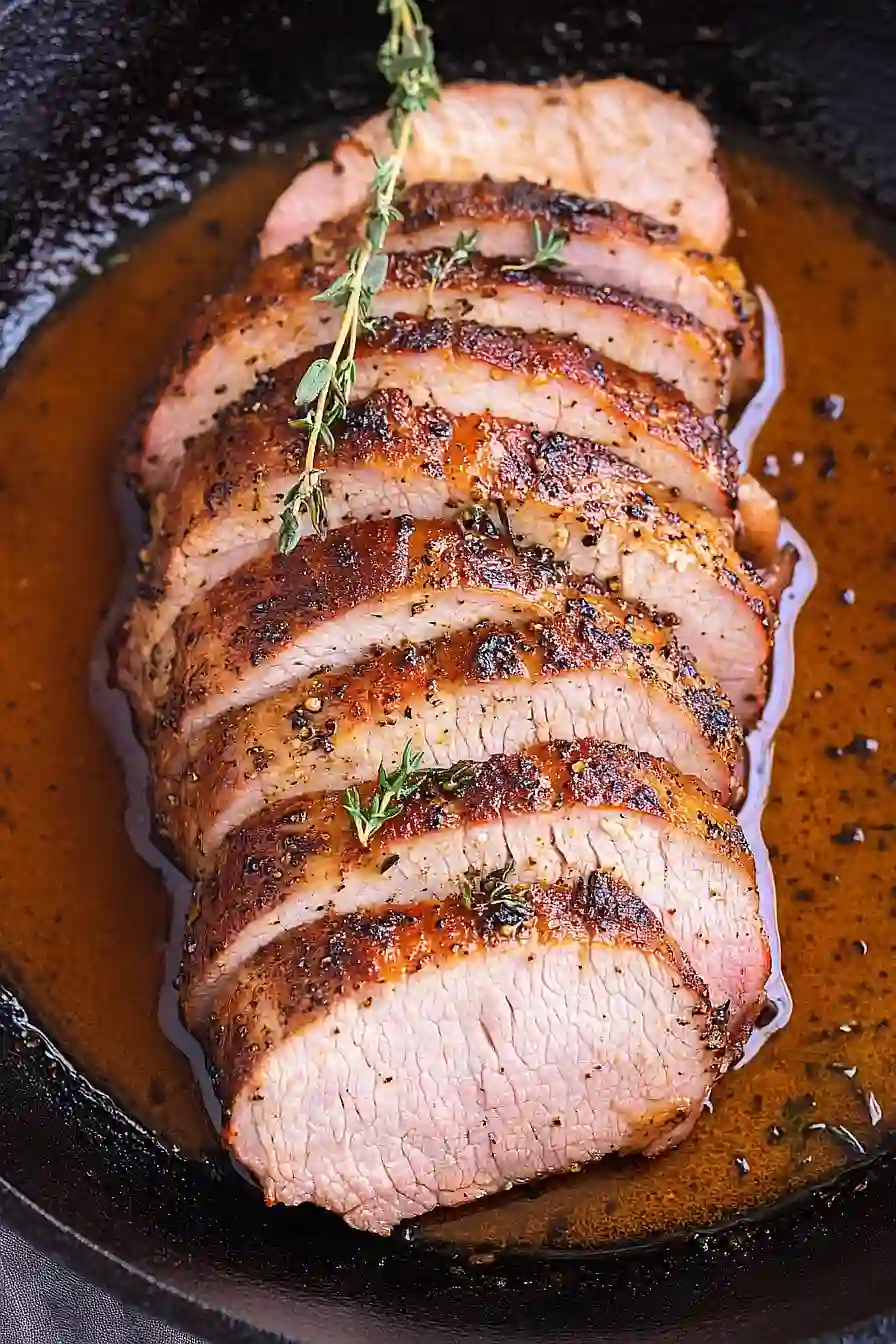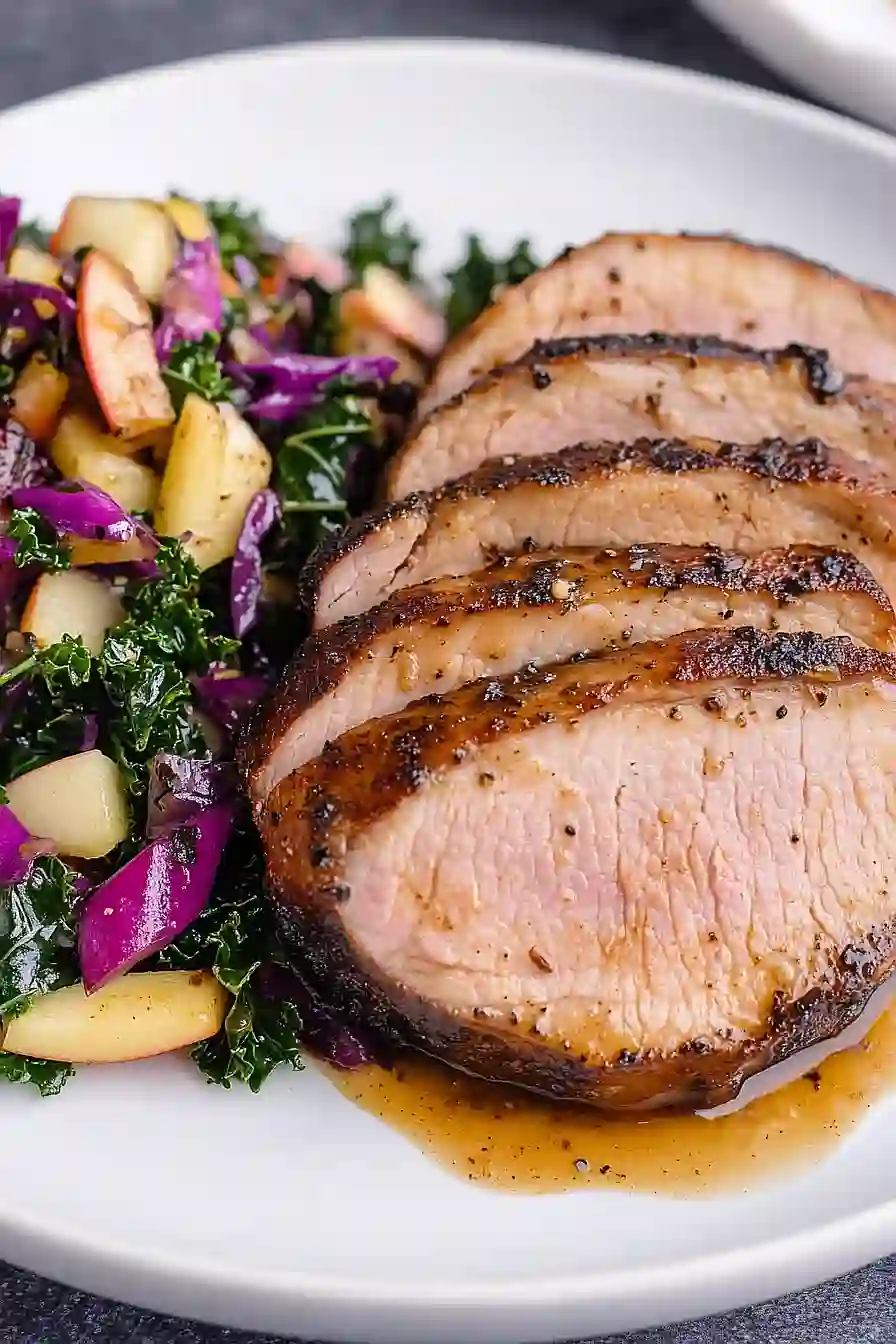Disclaimer: Our editors have used AI to create or enhance parts of this article. All content has been fact-checked by our team to ensure accuracy.
Here is my go-to cast iron pork tenderloin recipe, with a simple seasoning blend, perfect searing technique, and an easy oven finish that gives you juicy, tender meat every time.
This pork tenderloin has become our Sunday dinner staple. My kids actually ask for seconds, which is saying something! Plus, it’s fancy enough for company but simple enough for a regular weeknight meal.

Why You’ll Love This Cast Iron Pork Tenderloin
- Quick weeknight dinner – Ready in under an hour, this recipe is perfect when you want something special but don’t have all day to cook.
- Restaurant-quality results at home – The cast iron searing gives you that perfect golden crust while keeping the inside juicy and tender, just like your favorite steakhouse.
- Simple pantry ingredients – You probably already have most of these spices and staples in your kitchen, making this an easy go-to recipe.
- Impressive presentation – The maple Dijon glaze looks fancy enough for company but is simple enough for a regular Tuesday night dinner.
- One-pan cooking – Everything happens in your trusty cast iron skillet, which means less cleanup and more time to enjoy your meal.
What Kind of Pork Tenderloin Should I Use?
When shopping for pork tenderloin, look for a piece that’s around 1.25 to 1.5 pounds, which is the perfect size for this cast iron recipe. You’ll want to choose one that’s pinkish-red in color with minimal visible fat, and make sure it feels firm to the touch. Most grocery stores sell pork tenderloin in vacuum-sealed packages, and these work great for this recipe. Before cooking, be sure to remove the silver skin (that thin, shiny membrane) from the tenderloin using a sharp knife, as it can make the meat tough if left on.

Options for Substitutions
This pork tenderloin recipe is pretty forgiving when it comes to swaps:
- Pork tenderloin: If you can’t find tenderloin, pork loin works too – just adjust cooking time since it’s thicker. Chicken breast is another option, though you’ll want to reduce the cooking time significantly.
- White wine: No wine on hand? Chicken broth works perfectly, or you can use apple cider for a slightly sweet twist that pairs nicely with pork.
- Maple syrup: Honey or brown sugar can step in for maple syrup. Use the same amount of honey, or about 2 tablespoons of brown sugar mixed with 1 tablespoon water.
- Dijon and whole-grain mustard: If you only have one type of mustard, just use 2 tablespoons of whichever you have. Regular yellow mustard works in a pinch, though the flavor will be milder.
- Smoked paprika: Regular paprika works fine, or try chili powder for a bit more heat. The smoky flavor won’t be there, but it’ll still taste great.
- Cast iron pan: Don’t have cast iron? A regular oven-safe skillet works just fine – the key is making sure it can go from stovetop to oven.
Watch Out for These Mistakes While Cooking
The biggest mistake when cooking pork tenderloin is overcooking it, which turns this naturally tender cut into a dry, tough disappointment – always use a meat thermometer and pull it from the oven when it reaches 145°F internal temperature.
Another common error is not letting the meat rest properly after searing, so make sure to sear all sides in your hot cast iron pan before transferring to the oven, and don’t skip the 5-minute rest period after cooking to let the juices redistribute.
When making the pan sauce, avoid adding the butter while the pan is too hot or it will break and become greasy instead of creating that smooth, glossy finish you want.
Finally, don’t forget to deglaze the pan with your wine or broth while it’s still warm to capture all those flavorful browned bits from the bottom of the skillet.

What to Serve With Cast Iron Pork Tenderloin?
This maple-glazed pork tenderloin pairs beautifully with roasted vegetables like Brussels sprouts, carrots, or sweet potatoes that can cook right alongside it in the oven. The sweet and tangy flavors from the maple syrup and mustard glaze work really well with creamy mashed potatoes or garlic mashed cauliflower to soak up all that good pan sauce. For something lighter, try a simple arugula salad with apple slices and walnuts, or roasted green beans with almonds. Don’t forget to drizzle that maple-mustard pan sauce over everything – it’s way too good to waste!
Storage Instructions
Refrigerate: Leftover pork tenderloin keeps really well in the fridge for up to 4 days when stored in an airtight container. I like to slice it up before storing so it’s ready to go for quick lunches or dinner additions. The maple mustard glaze actually gets even more flavorful after a day or two!
Freeze: You can freeze cooked pork tenderloin for up to 3 months in freezer-safe bags or containers. I recommend slicing it first and freezing portions flat so they thaw more evenly. The texture will be slightly different after freezing, but it’s still great for sandwiches or adding to pasta dishes.
Reheat: Gently warm sliced pork in a skillet over medium-low heat with a splash of broth or water to keep it moist. You can also reheat it in the microwave on 50% power, checking every 30 seconds. Don’t overcook it or it’ll get tough – just warm it through until heated.
| Preparation Time | 10-15 minutes |
| Cooking Time | 25-35 minutes |
| Total Time | 35-50 minutes |
| Level of Difficulty | Medium |
Estimated Nutrition
Estimated nutrition for the whole recipe (without optional ingredients):
- Calories: 1300-1500
- Protein: 100-110 g
- Fat: 80-90 g
- Carbohydrates: 50-60 g
Ingredients
For the pork tenderloin:
- 1 pork tenderloin (1.25 to 1.5 lb)
- 1 tbsp olive oil
- 1/2 tsp kosher salt
- 1/2 tsp ground black pepper
- 1 tsp garlic powder
- 1 tsp dried thyme
- 1 tsp smoked paprika
- Oil for searing
For the pan sauce:
- 1/4 cup white wine or chicken broth
- 3 tbsp pure maple syrup
- 1 tbsp dijon mustard
- 1 tbsp whole-grain mustard
- 1 tbsp lemon juice
- 3 tbsp butter
Step 1: Prepare and Season the Pork Tenderloin
- 1 pork tenderloin (1.25 to 1.5 lb)
- 1 tbsp olive oil
- 1/2 tsp kosher salt
- 1/2 tsp ground black pepper
- 1 tsp garlic powder
- 1 tsp dried thyme
- 1 tsp smoked paprika
Preheat the oven to 400°F.
Pat the pork tenderloin dry with a paper towel, then trim away any excess silver skin using kitchen scissors or a sharp knife.
Drizzle the tenderloin with olive oil and season evenly with kosher salt, ground black pepper, garlic powder, dried thyme, and smoked paprika.
Rub the seasonings and oil all over the meat to fully coat it.
Step 2: Sear the Pork Tenderloin
- oil for searing
- seasoned pork tenderloin from Step 1
Heat a small amount of oil for searing in a large cast iron skillet over medium-high heat.
Once the skillet is hot, add the seasoned pork tenderloin from Step 1.
Sear the tenderloin for 3-4 minutes per side, turning to brown all four sides, until it is deeply golden brown all over.
This process should take about 15 minutes total.
Step 3: Roast the Pork Tenderloin in the Oven
- seared pork tenderloin from Step 2
Transfer the cast iron skillet with the seared pork tenderloin from Step 2 to the preheated oven.
Roast the pork for 10-15 minutes, or until a meat thermometer inserted in the thickest part reads 145°F.
Remove the skillet from the oven.
To keep the pork juicy, do not let it cook past 145°F.
Step 4: Rest the Pork Tenderloin
- roasted pork tenderloin from Step 3
Remove the pork tenderloin to a cutting board and let it rest for 15 minutes while you prepare the sauce.
You can tent it loosely with aluminum foil to retain warmth, though it’s not strictly necessary since it will be served with the warm sauce.
This resting step is important for juicy, flavorful slices.
Step 5: Make the Maple Mustard Pan Sauce
- 1/4 cup white wine or chicken broth
- 3 tbsp pure maple syrup
- 1 tbsp Dijon mustard
- 1 tbsp whole-grain mustard
- 1 tbsp lemon juice
- 3 tbsp butter
With the skillet over medium-low heat, deglaze the pan with white wine or chicken broth, scraping up all the browned bits from the bottom.
Let the liquid sizzle and reduce slightly.
Add the maple syrup, Dijon mustard, whole-grain mustard, and lemon juice, whisking until smooth and combined.
Turn off the heat and whisk in the butter until the sauce is glossy and smooth.
I like to take a moment to taste the sauce here—sometimes a tiny pinch of extra salt or a squeeze of lemon makes it really pop.
Step 6: Slice and Serve the Pork Tenderloin
- rested pork tenderloin from Step 4
- maple mustard pan sauce from Step 5
Slice the rested pork tenderloin from Step 4 into 1-inch thick pieces.
Arrange the slices on a serving platter and generously spoon the warm maple mustard sauce from Step 5 over the top.
Serve immediately as part of a delicious meal.
For an extra special touch, I sometimes serve this dish with kale and apple slaw, sweet potatoes, or hot honey Brussels sprouts.

